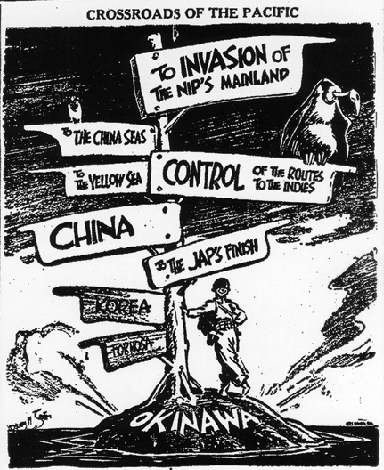Battle For Okinawa: World War II | home
After Okinawa: Target Japan
 The Planned Attack Of The Japanese Homelands
The Planned Attack Of The Japanese Homelands "...The sooner the Americans come,
the better...One hundred million...
...die proudly..."
- Japanese slogan in the summer of 1945
Operation Downfall
Operation Olympic
Operation Coronet
x - Day
Before the conclusion of the war, plans were maturing for the invasion and occupation of the main Japanese islands; Under the main title of Operation Downfall.
Two major operations were projected: the first, with the code name of "Olympic," against southern Kyushu; after consolidation there, the next-"Coronet"-into the Tokyo plain area which is the industrial heart of Japan.
The amphibious parts of these operations-involving the preparation of landing beaches by mine sweeping, underwater demolition teams, bombardment and bombing; the transportation of the assault troops; and the initial landing for the establishment of firmly held beachheads-were to have been the responsibility of Fleet Admiral Nimitz.
The large-scale bombardments and bombings of the Third Fleet that began on 10 July were actually in preparation for operation "Olympic." In mid-August, as the war ended, the United States Navy had in the Pacific 90 per cent of its combatant vessels of submarine size or larger and 42 per cent of its combatant aircraft. These ships, aircraft, support auxiliaries and landing craft include:
Battleships 23
Aircraft carriers 26
Escort carriers 64
Cruisers 52
Destroyers 323
Escort vessels 298
Submarines 181
Mine craft 160
Auxiliary vessels 1,060
Large landing craft 2,783
Combat aircraft 14,847
Transport, training and utility aircraft 1,286
Six Marine Divisions, 100% per cent of the Marine Corps combat strength, were also available for Pacific operations.
The "Olympic" and "Coronet" operations as planned would have been the largest amphibious operations in history. While the third Fleet provided strategic cover and support for the amphibious forces making the invasion, the Fifth Fleet was to have executed the amphibious phases of the invasions of Kyushu and Honshu by transporting their troops and equipment to the attack position on shore.
By the application of naval force they would have established the necessary ground troops in positions favorable for further maneuvers to complete the destruction of Japanese ground forces.
In discharging its responsibities for the amphibious phase of the Kyushu or "Olympic" operation the United States Navy would have employed 3,033 combatant and noncombatant vessels of a size larger than personnel landing boats. The entire operation was flawed from a strategic standpoint and the story is facinating.
Japanese Fantiticism
Japanese Operation Ketzu-Go & Millions of Casualties
|